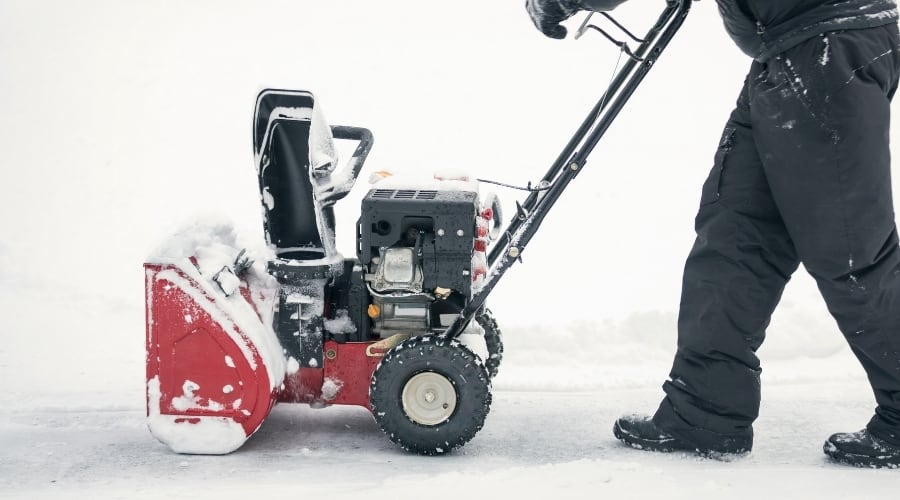A three-stage snowblower is often fifty percent faster than a similarly sized two-stage blower. The machine’s physical dimensions don’t determine its power or speed, just how deep the snow it can handle.
It’s crucial to select your blower based on how much time you have and the weather in your area. Can a snowblower freeze? I’ll walk you through everything you need to know to keep your snowblower running, no matter its size.
A Snowblower engine, impeller and belt can freeze and lock up, refusing to move, which is more common immediately after use. Leaving the machine outside and not properly stored or maintained will cause freezing rain to cover it in ice and develop water vapor and ice internally. Run auger to clear snow out of snowblower before storing in garage.
Table of Contents
Can Snowblower Freeze Up
Numerous parts of a snowblower can freeze up, so the solution depends on where the problem lies. In the two and three-stage blowers, the impeller is one of the parts that have this issue often.
Moreover, a freeze is more likely to occur soon after you finish using the machine. Especially if you are storing your snowblower anywhere, the temperature is below zero. Freezing weather leads to frozen parts.
The warmth of the machine, while it’s in use, will melt snow, but the water quickly becomes ice as your blower cools down.
Whenever possible, it’s best to store your snowblower indoors in an insulated tool shed or garage. Doing this will allow the water to drip off the machine instead of freezing solid and blocking the impeller or other parts of your blower.
Below are three additional steps you can take to prevent impeller freeze up.
- Leave your machine running for several minutes after you finish working. By doing this, the augur and impeller have time to clear more snow off of themselves.
- Shut down your machine entirely. When you’re confident it’s no longer running, use a tool to clean off any additional snow or ice you can reach. If you have compressed air, it can be beneficial for dusting off the impeller and augur.
- According to TransNorth, you can also add a heat source like an incandescent bulb and tarp over your machine to hold the small amount of heat near your snowblower. I recommend using a tarp with a silvery reflective inside to help amplify the heat within the cover.
Can Gas Freeze In A Snowblower
Unless you live in Antarctica or we experience another sudden onset ice age, the gas in your snowblower should not freeze.
However, gas isn’t the only thing that can get inside your gas tank. Sometimes water vapor collects inside your machine, which can quickly become ice.
Ice in your gas is a significant problem for three reasons. First, it will block up the flow through your carburetor and pistons.
Second, it will sink to the bottom of the tank, below the gas, as it warms up and flows into the engine. Third, water can cause corrosion within your tank.
Sadly, too much water freezing inside your snowblower can even crack the engine block.
According to Family Handyman, “In order for gasoline to freeze it needs to be held at temperatures of around -100 degrees F. That number will vary depending on the components that make up your gasoline (octane, for example, has a higher freezing point), but the point remains the same.”
Can A Snowblower Engine Freeze Up
When your engine freezes up, it is called seizing. Typically, this isn’t because of the temperature but rather a result of other issues in your machine.
For example, when an engine vapor locks, it won’t run because fuel and air aren’t moving through the engine, and there’s a vacuum or blockage.
If the gas is frozen, it’s not the actual fuel but the water inside the tank causing the problem. You can drain the machine, clean the carburetor and refill it with clean, water-free gas.
Ensure that you fill the tank and store it covered or indoors to prevent more water from getting inside. Frozen cables can also make the engine refuse to run.
In this case, there’s water inside, and the solution is the same. Let the machine thaw out.
Finally, the belt can freeze and refuse to turn if there’s too much moisture collecting inside. This isn’t a frozen engine.
Thawing will often work on this problem, but rubber is also susceptible to cold and can break if the material freezes and then tries to move. When this happens, the only thing you can do is replace a damaged belt.
How Do I Keep My Snowblower From Freezing
A frozen snowblower is useless, but there are plenty of ways to help keep your snowblower from freezing up. With a little bit of effort and some commonsense maintenance, you won’t need to worry.
The list below will show you how to keep your snowblower moving and not freeze.
- Always remove your wheels and grease the axle. Doing this will keep your axle from getting wet or damaged and make sure the wheels move.
- Treat the inside of your chute and augur with a nonstick coating at the beginning of each snowy season. Doing this helps prevent snow and ice from sticking to the machine, which causes it to stop blowing snow. Additionally, it will help keep any dirt or grass from blocking up your snowblower.
- Move as fast as you can. Chugging along too slowly can impede the function of your blower.
- Fill your gas tank up completely before you put it away to prevent moisture from getting into your gas. It would be best if you also used a good stabilizer in your fuel to help keep the parts of your engine moving.
- Run your augur until the chute is completely empty after you’re done rather than leaving snow inside to melt or freeze.
- Never use your hands to clean the augur. Instead, opt for an excellent clean-out tool. This helps prevent injuries, but it also helps ensure the machine is empty of snow when you put it away.
Helpful Tips To Know If A Snowblower Can Freeze
Snowblowers can freeze in so many ways. It’s essential to understand which parts are causing the problem. When in doubt, start by simply thawing the whole machine. Sometimes that will solve the problem.
Below I’ve provided a few other helpful tips to know if a snowblower can freeze.
- When you can’t pull the rope on a single stage snowblower, it’s because the recoil starter is frozen. You can use a heat gun or hairdryer to warm this up carefully if you’re in a rush. Otherwise, place the snowblower somewhere warm and let it thaw out naturally.
- Cold metal is a problem for people as well as engines. Prevent your hands from freezing on your snowblower by wearing suitable gloves or using heated handles.
- Manual starters can have trouble engaging in freezing weather. Opt for an electric starter to resolve this issue.
Final Thoughts
No one wants a snowblower that’s as frozen as the ground it needs to cover. Fortunately, proper maintenance and storage can prevent both types of freezing.
Remember to run your augur until there’s no snow left inside, and fill the gas tank up fully before storing, so there’s no room for water vapor.
Additionally, you should always keep a snowblower indoors, somewhere that gets some heat, or cover it and place it against a wall in your garage shares with the house.
Otherwise, make sure you bring the machine up above freezing before turning it on to keep your snowblower in good working order.

